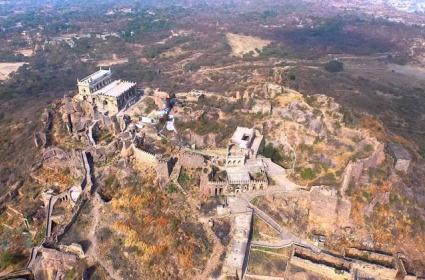Incredible Telangana

By Ravi Valluri
A cool breeze wafts across as one runs, jogs or merely strolls on Tank Bund, be it early mornings or late evenings. Any individual can see the majestic statue of Buddha in the middle of the Hussain Sagar Lake.
Welcome to the land of Telangana!
The Kakatiya dynasty was a South Indian dynasty and their capital was Orugallu, in modern times known as Warangal. The dynasty was eventually over run by the Delhi Sultanate; Warangal is an integral part of the newly formed state of Telangana. Rani Rudrama Devi (1259−1289 AD) was one of the most prominent rulers of the Kakatiya dynasty on the Deccan Plateau. She, along with Rani Chennamma and Rani Lakshmi Bai of Jhansi were among the few women in medieval Indian history who carved a niche for themselves as formidable and valorous rulers and administrators.
Throughout antiquity and down the Middle Ages, the region now known as Telangana was ruled by multiple major Indian powers such as the Cholas, the Mauryans, the Satavahanas, the Chalukyas, the Kakatiyas, the Delhi Sultanate, the Bahmani Sultanate and the Golconda Sultanate. During the 16th and 17th centuries, the region was ruled by the Mughals. In the 18th century, during the British Raj, Telangana was ruled by the Nizam of Hyderabad. In 1823, the Nizam lost control over the Northern Circars (Coastal Andhra) and the Ceded Districts (Rayalaseema), which were then handed over to the East India Company. The annexation by the British of the Northern Circars deprived the Hyderabad State, the Nizam's dominion, of the considerable coastline it formerly had, reducing its status to that of a landlocked princely state with territories in Central Deccan, bounded on all sides by British India.
Hyderabad State joined the Union of India in 1948 after an Indian military invasion. In 1956, the Hyderabad State was dissolved as part of the linguistic reorganisation of states and Telangana was merged with the Telugu-speaking Andhra State (a part of the Madras Presidency during the British Raj) to form Andhra Pradesh. A peasant-driven movement began, to advocate for separation from Andhra Pradesh starting in the early 1950s, and continued until Telangana was finally awarded separate statehood.
The twin states of Andhra Pradesh and Telangana were formed by an act of Parliament and two independent states were carved out from undivided Andhra Pradesh. On 2 June 2014, the area in the north-western part of Andhra Pradesh was separated as the newly formed 29th state with Hyderabad as its historic permanent capital. Its other major cities include Warangal, Nizamabad and Karimnagar. Telangana is bordered by the states of Maharashtra to the north, Chhattisgarh, Karnataka to the west, and Andhra Pradesh to the east and south as well. Telangana consists mostly of hills, mountain ranges, and thick dense forests covering an area of 27,292 sq. km.
Though Telangana is a newly formed state, it is enriched in culture, tradition and architecture. This geographical entity is fabled for its historical past and exalted tradition.
Denizens of varied castes and creeds, professing multifarious faiths live in harmony on this land. This is a testimony to unity in diversity and the pluralistic traditions the state stands for. This alluring and prepossessing land has now become an IT hub and an important tourist destination. The state has also emerged as a major focus for robust IT and software and industry and services sectors. The state is also the main administrative centre to a large number of Indian defence aerospace and research labs like Bharat Dynamics Limited, Defence Metallurgical Research Laboratory, Defence Research and Development Organisation and Defence Research and Development Laboratory.
During the high noon of the Chalukyas and the Kakatiyas’ reign the region flourished with amazing structures such as the 7th century Navabrahma temple at Alampur, the robust and formidable Warangal Fort, the Ramappa Temple, the Kotta Gullu and the Thousand Pillar Temple which are still breathtaking sights to behold. A little later, the dawn of Indo- Islamic architecture marks the construction of Golkonda Fort, the lofty Charminar and aerobicized Qutub Shahi Tombs and mosques.
Handicrafts are a remarkable feature of any place, which speaks of the exceptional crafting skill of the people living there. These souvenirs not only adorn the house but are also sweet memories of the times well spent and places visited. Such remarkable handicrafts can be found amply in Telangana, a state known for its rich history and culture. Even in today’s modern world, we can find lots of men who are passionate about these traditional handicrafts and do this not for livelihood but purely out of love. Be it needle craft or bronze castings, metal craft or stone craft, Telangana has a wide array of handicrafts that can become a part and parcel of your home.
The cuisine of Telangana is particularly legendary. To be specific the Hyderabad Dum Biryani in Telangana scores an ace among tourists and also among the denizens who inhabit the twin cities of Hyderabad and Secunderabad. In particular, biryani from the hugely popular ‘Paradise’ is devoured by backpackers from across the world.
“Whether we like it or not, we all come from someplace. And at some point in our lives, we have to make peace with that place,” writes the noted author Jeffrey Stepakoff.
Also Read: History Of Verdant Godavari
Also Read: Wanderlust In Tamil Nadu And Puducherry
Also Watch: Nani Dubs For Simba In Lion King Telugu
Also Read: Sridevi Death Not Accidental Drowning, Forensic Surgeon’s Sensational Claim On Actress Murder



















